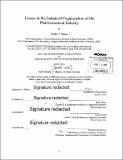| dc.contributor.advisor | Nancy Rose and Ernst Berndt. | en_US |
| dc.contributor.author | Shapiro, Bradley T. (Bradley Thomas) | en_US |
| dc.contributor.other | Massachusetts Institute of Technology. Department of Economics. | en_US |
| dc.date.accessioned | 2014-09-19T21:41:38Z | |
| dc.date.available | 2014-09-19T21:41:38Z | |
| dc.date.copyright | 2014 | en_US |
| dc.date.issued | 2014 | en_US |
| dc.identifier.uri | http://hdl.handle.net/1721.1/90132 | |
| dc.description | Thesis: Ph. D., Massachusetts Institute of Technology, Department of Economics, 2014. | en_US |
| dc.description | Cataloged from PDF version of thesis. | en_US |
| dc.description | Includes bibliographical references. | en_US |
| dc.description.abstract | This dissertation comprises of three chapters, each exploring different issues in the industrial organization of the pharmaceutical industry. In the first chapter, I study the effects of television advertising of antidepressants using a novel method comparing households near the borders of television markets. I find that advertising has positive benefits on the market as a whole, including competitors. Using this information and a simple supply model, I consider the counterfactual whereby firms work together in a co-operative. In the co-operative equilibrium, firms advertise more than five times as much as is observed in competitive equilibrium and profits would increase by about twenty percent. In the second chapter, the documented phenomenon of strategic entry delay is analyzed in the sleep aid industry in order to measure the cost to consumers of that delay. With the Hatch-Waxman Act of 1984, the FDA included an unchallengeable exclusivity period for new approved drugs, independent of patents. This generates an incentive for firms to strategically delay the introduction of new versions of drugs until just before patent expiration of the originals in order to take market share away from new generics rather than its own original product in its time of FDA exclusivity. Using detailed prescribing and pricing data, I document that delay and estimate cost to consumers in the prescription sleep aid market at about $644 million over seven years. In the final chapter, we examine firm behavior following the loss of exclusivity (LOE) of six molecules between June 2009 and May 2013 that were among the 50 most prescribed molecules in May 2013. We analyze speed of generic firm entry, prices, generic and penetration separately by four payer types (cash, Medicare Part D, Medicaid, and other third party payer -TPP) and by age (under vs. over 65). We find modest price decreases following LOE but very rapid and complete penetration of generics. While on average molecule prices decrease, the branded versions continue to increase prices after LOE. Expansion of molecule sales is increasingly common. Generic penetration rates are typically highest and most rapid for TPPs, and lowest and slowest for Medicaid. Cash customers and seniors generally pay the highest prices, TPPs and those under 65 pay the lowest prices. The presence of an authorized generic is also analyzed and found to have effects that vary across molecule. | en_US |
| dc.description.statementofresponsibility | by Bradley T. Shapiro. | en_US |
| dc.format.extent | 125 pages | en_US |
| dc.language.iso | eng | en_US |
| dc.publisher | Massachusetts Institute of Technology | en_US |
| dc.rights | M.I.T. theses are protected by copyright. They may be viewed from this source for any purpose, but reproduction or distribution in any format is prohibited without written permission. See provided URL for inquiries about permission. | en_US |
| dc.rights.uri | http://dspace.mit.edu/handle/1721.1/7582 | en_US |
| dc.subject | Economics. | en_US |
| dc.title | Essays in the industrial organization of the pharmaceutical industry | en_US |
| dc.type | Thesis | en_US |
| dc.description.degree | Ph. D. | en_US |
| dc.contributor.department | Massachusetts Institute of Technology. Department of Economics | |
| dc.identifier.oclc | 890150485 | en_US |
